Archive for the ‘Shelf Life: Book Reviews’ Category
Cozy fiction is still on the rise, and I’m here for it. The more hectic life gets, the more appealing it becomes to read stories about likeable characters just kind of living their lives and vibing without any clear stakes or massive conflicts to deal with. That lack of a clear plotline is supposed to be storytelling poison according to conventional wisdom, but I’m happy to learn I’m not the only weirdo who has been liking books that my high school English teachers would have had a fit over.
That lack of a clear plotline is also the point of Royal Red by K.C. Shaw, a cozy fantasy adventure in a quaint world of domestic dragons that promises “Art. Adventure. And lots of tea.” And it delivers all three in spades, even if that second bullet point is very low-key and personal throughout.
Rose is a dragon and an artist living in a co-op of other artist dragons, but lately she’s found herself in a slump and unhappy with her style of painting. At the urging of her mentor and roommates, she packs up some funds and some art supplies and flies away from her homeland for the first time to travel abroad and experience more of the world in the hope of growing and evolving as an artist and a person.
And that right there is the start and finish of the plot. Rose gets up to a handful of unexpected adventures on her travels, meets other dragons in a wide range of personalities and likeability, paints a lot of different subjects, and has a lot of little meals and tea breaks along the way. To dwell too much on any detail of her journey counts as a spoiler, because the whole thrust of the book is wondering what the next little event will be on Rose’s mostly aimless tour of self-discovery.
Read more after a tea break
Tags: book, book review, fantasy, paperback, review, shelf life, story
Posted in Shelf Life: Book Reviews |
Life comes at you fast, and these past few years have come with a whole lot of extra life stuff to deal with. So it’s been a bit of a while since I’ve actually read much of anything, much less read anything to completion, and much less even than that read anything that’s left me with strong enough feelings to write another one of these.
But then I saw this book on a little shelf in a thrift shop a couple months ago offering “high fantasy and low stakes,” and it looked like the kind of chill, cozy, light read that might lull me back into reading more regularly.
The jury’s still out on that point, because busy life things are still happening and I only just finished this book; but regardless, Legends and Lattes by Travis Baldree definitely delivers on the “slow down, take a breath, have a nice time” vibes it was giving. It is, in a word, charming.
The story follows Viv, a freshly retired orc barbarian who’s decided to swap her greatsword for a bean grinder and get away from the bloody, hectic life of a professional adventurer. To this end, she rolls up in the city of Thune with a nest egg and a plan: introduce the townsfolk to this wonderful gnomish concoction she fell in love with on her travels, a liquid hug in a mug called “coffee.”
Read more at your leisure
Tags: book, book review, fantasy, review, shelf life, story
Posted in Shelf Life: Book Reviews |
Tags: book recommendation, fantasy, fantasy novel
Posted in Shelf Life: Book Reviews |
Heart of Sherwood was an enjoyable read. I love the idea of Robin Hood being a woman in disguise, and I’m surprised I haven’t seen it done before (the closest I’ve seen is the movie Princess of Thieves, in which Keira Knightley played Robin Hood’s daughter disguised as a boy). The story included the well-known beats and characters of the Robin Hood legend but also sprinkled in historical details and political intrigue appropriate to the time period of the Third Crusade.
Read on »
Tags: book review, historical fiction, lesbian romance, LGBTQ
Posted in Shelf Life: Book Reviews |
I absolutely loved this book. I love faerie lore (both traditional and reimagined in a second world setting), and Shadowfell is full of faerie creatures. While there are your more well-known creatures like will-o-wisps, pixies, brownies, and redcaps, there were a few new ones to me, such as the stanie mon, brollochan, and urisk. Probably my favorite was the Guardian of the South, a trickster figure of fire that can shift between an old man, a young boy, and a fierce warrior. He definitely reminded me of Loki, and I’m anticipating reading more about him as the series goes on.
Read more
Tags: book review, fantasy, novel, YA, young adult
Posted in Shelf Life: Book Reviews |
One of my favorite storytelling tropes is the found family. I thought Mad Max: Fury Road was one of the best movies of the past decade. I still unironically enjoy pirate stories. Badass ladies are badass.
So Seafire by Natalie C. Parker is checking a lot of my boxes.
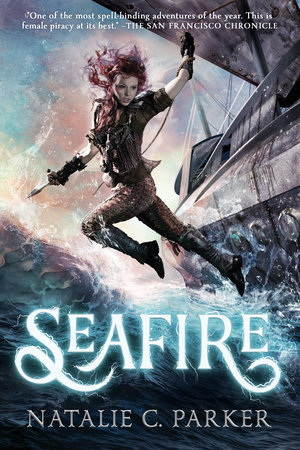 Seafire is a swashbuckling dystopia following Caledonia Styx, a young woman on the run from a powerful warlord Aric Athair. After her family is ambushed and murdered by a crew of the warlord’s Bullets — loyal soldiers groomed from childhood for violence and controlled by mandatory drug addiction — Caledonia is forced to turn from refugee to pirate captain, sailing the high seas with her all-female crew of rebels and renegades aboard the Mors Navis, taking the fight to Aric’s forces by targeting his fleet of floating garden barges where the flowers that fuel his drug production are grown.
Seafire is a swashbuckling dystopia following Caledonia Styx, a young woman on the run from a powerful warlord Aric Athair. After her family is ambushed and murdered by a crew of the warlord’s Bullets — loyal soldiers groomed from childhood for violence and controlled by mandatory drug addiction — Caledonia is forced to turn from refugee to pirate captain, sailing the high seas with her all-female crew of rebels and renegades aboard the Mors Navis, taking the fight to Aric’s forces by targeting his fleet of floating garden barges where the flowers that fuel his drug production are grown.
But when one of Aric’s Bullets tries to defect to Caledonia’s side, saving the life of her best friend in the process, the captain’s survival tactics and deep-seated beliefs are called into question. On the one hand, he represents everything she and her crew despise, and keeping him aboard could mean all of their deaths; after all, trusting a Bullet was what led to her family’s deaths. On the other, if he’s telling the truth, he might hold the key to taking down Aric once and for all — and to Caledonia being reunited with the little brother that she thought she’d already lost long ago.
Read more aboard the Mors Navis
Tags: book, dystopian, found family, girl power, Natalie C. Parker, nautical, pirates, review, shelf life, story, swashbuckling
Posted in Shelf Life: Book Reviews |
This is kind of a hard review to write, just because I’ve already written it once already, so now I have to try not to repeat myself. Part of me just wants to drop a link here to my review of the first book in the series, The Grey Bastards, and leave it at that. And while I won’t actually be that lazy, I will go ahead and link that first review — check it out here, if you’ve a mind.
Honestly, I’m not sure at first what to say here besides: Did you read The Grey Bastards? Did you like it? Because this is more The Grey Bastards: more sprawling storylines weaving together in unexpected ways; more tough-as-nails, foul-mouthed, badass characters with flexible moral compasses; more unapologetic grit and grime and gut-strewing; more peeks into the nooks and crannies of a unique and beautifully built but cruelly unforgiving world; more sex; more violence; and more robust bacon flavor.
Also, to lift another similarity from the first review, more quick notes worth disclosing. First off, spoilers for the first Bastards book, obviously, so go read that if you haven’t yet before you read this. Second, for the sake of transparency, Jonathan French is still a friend of ours — someone we thanked as a mentor figure in our own debut self-published novel, and someone whose work we’ve been promoting at conventions and on social media and such as Bastards ambassadors (aka “ambastards”). We got advanced reader copies of The True Bastards about a month before the book goes/went on sale to the public, depending on when you’re reading this.
Take all of that into consideration if you want — but also know that, like The Grey Bastards before it, we don’t need no incentives to tell people that this book is damn good. This shit is my jam, and I was gonna read it and love it whether or not the author knows what my face looks like. The fact that I got to do it a month ahead of most other people was just a nice bonus and an incidental early birthday present.
Got all that? Cool, back the fun part.
Read to the end, ya bastard!
Tags: book, fantasy, Jonathan French, orcs, review, shelf life, story
Posted in Shelf Life: Book Reviews |
Judge this book by its cover. I did, and I wasn’t disappointed.
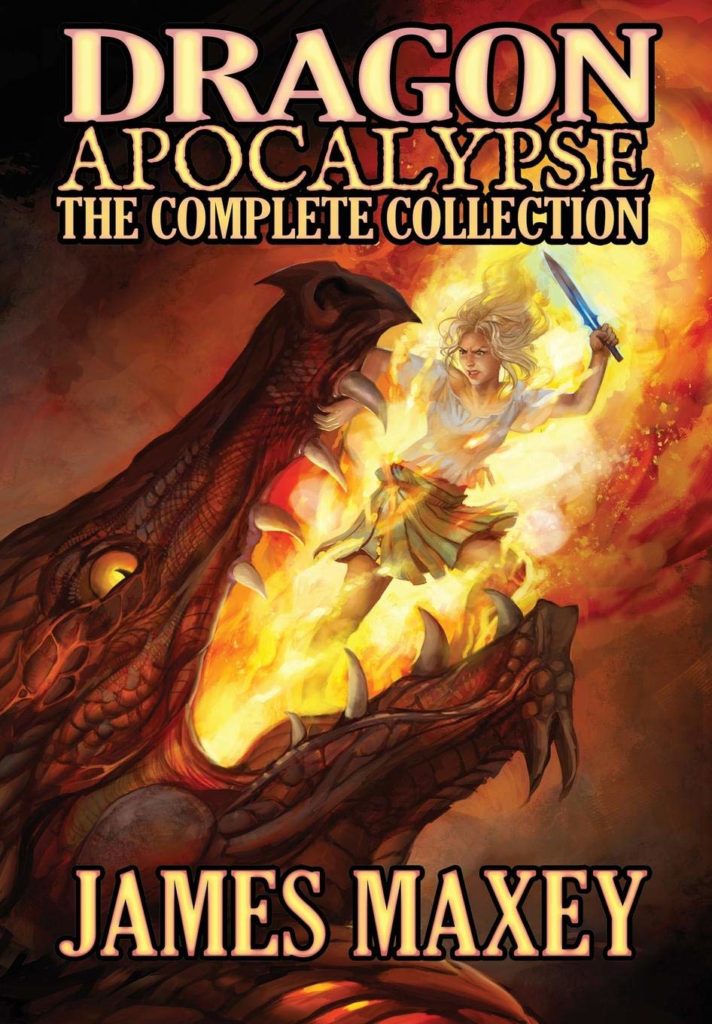 Dragon Apocalypse: The Complete Collection by James Maxey is a thick-as-a-brick compilation of four hack-n-slash action fantasy novels (plus the original short story that inspired them): Greatshadow, Hush, Witchbreaker, and Cinder (plus “Greatshadow: Origins”).
Dragon Apocalypse: The Complete Collection by James Maxey is a thick-as-a-brick compilation of four hack-n-slash action fantasy novels (plus the original short story that inspired them): Greatshadow, Hush, Witchbreaker, and Cinder (plus “Greatshadow: Origins”).
Just to be thorough, I did a quick image search of each individual novel’s cover art, and my initial thesis still holds up. Badass lady jumping down a dragon’s throat, small woman with big hammer versus ice dragon in a frozen wasteland, dragon attacking ship on a storm-wracked sea, they all check out. And they’re all pretty good indicators of what kinds of stories to expect on the following pages.
Read to the end (of the world)
Tags: anthology, book, cinder, fantasy, greatshadow, hush, indie author, infidel, James Maxey, review, shelf life, story, witchbreaker
Posted in Shelf Life: Book Reviews |

Avast, Ye Airships! is a wonderful little gem of steampunk airship fantasy. All of the stories in it are well-written and intriguing. While they all have the same premise, a steampunk story set on an airship, each author contributes a story that is completely original and different from the others. While some are more “traditional” steampunk (Victorian England), there are others that are romance, adventure, scifi, horror, and even Southern steampunk. The stories are varied in length and style.
My personal top five were “Maiden Voyage,” in which a lesbian couple must outwit the pirates seizing their ship, “Captain Wexford’s Dilemma,” in which a captain suddenly finds her airship has been possessed by ghosts after mooring near a cemetery, “Hooked,” in which a young lady, on her first airship adventure, finds the ship under attack by a dashing rogue, “A Steampunk Garden,” in which a clever mechanic must outwit her captors, and “Lotus of Albion,” in which an airship captain falls for a beautiful woman whom he believes to be a damsel in distress.
What I really appreciated was the careful attention to diversity. The stories in this book included people of color, queer characters, those with disabilities, and strong female characters. This one is well-worth the read.
Tags: airship, anthology, book review, steampunk
Posted in Shelf Life: Book Reviews |
I know it’s gauche to start an essay with a definition, but bear with me for a second, I promise it’s relevant.
Pulp fiction is technically defined by how it’s published, in magazines made with inexpensive wood pulp paper, priced cheaply to be sold and read in bulk. Sometimes this “quantity over quality” approach applied to the stories themselves, but sometimes it didn’t; pulp fiction, like all fiction, is only as good or as shoddy as the author writes it.
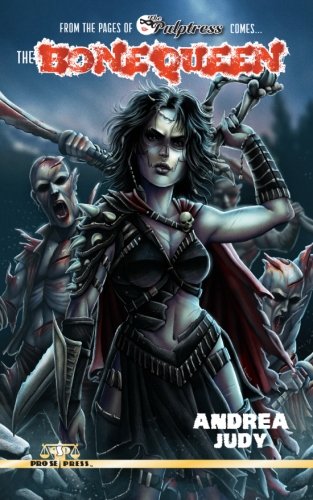
But beyond the technicalities of publishing, pulp fiction also developed a sort of overarching genre definition based on some recurring themes that tended to crop up in the stories again and again, regardless of categories like fantasy, noir, horror, etc. — namely, big, bombastic heroes squaring off against sinister, mysterious villains in dangerous, exotic locales, featuring beautiful women of both the damsel and the deadly variety.
All of this is to underscore that pulp fills a certain niche in fiction, and that The Bone Queen by Andrea Judy (disclaimer: another indie author friend of ours for several years now) falls squarely into this niche, so the answer to the question “But is it good, though?” will vary depending on where a reader stands in relation to said niche.
Do I like it? Yeah, I think it’s pretty good. The narrative isn’t deep or particularly nuanced; it doesn’t ask any tough questions or make many thoughtful moral arguments; and the fact that it’s an origin story for a character named “the Bone Queen” means you kind of know where the book is going to end up, more or less, from the word “go.” But it’s an entertaining trip getting there, straightforward and simple and fun, and full of rotten, visceral imagery, dark magic, and bone-crunching (in the most literal sense possible) action.
Read down to the bone
Tags: Andrea Judy, book, fantasy, indie author, pulp, Pulptress, review, shelf life, story, supernatural, zombie
Posted in Shelf Life: Book Reviews |
Out of the Shadows by Dana Fraedrich really scratched the steampunk itch I’ve been having lately. I especially enjoyed that the book was set in a unique steampunk world, rather than Victorian England. In fact, the unique world that it is set in means that one could also classify it as magicpunk.
The book takes place in Springhaven, a London-esque city in the small country of Invarnis. While Springhaven appears idyllic and tranquil on the surface, in reality, it is a dystopian society run by Enforcers who take a zero-tolerance policy to what they deem criminal activity. Criminal activity includes your usual—theft, rape, murder—but also means any sort of resistance against the established order. This includes befriending or assisting anyone deemed a criminal.
The main character, Lenore Crowley, has been an orphan for around a year at the start of the book because her parents were taken away for defying those in charge. She believes them to be dead, but learns later on that their fate was much worse—they are in a prison where they are tortured daily for information and the sheer sadistic pleasure of the Enforcers.
What I found especially interesting about the world building in Out of the Shadows is that Lenore’s society is built upon the remains of the Old World. Nobody is entirely certain what the Old World was or what happened to it, but they do know that in the Old World, magic, supernatural creatures, and fantastical events occurred which no longer exist (or so everyone believes). As readers, we are not even entirely sure how long ago the Old World ended. Thousands of years, hundreds, or just decades? It is my guess that the end of the Old World may have been brought about by the same iron hand that now rules Lenore’s society.
Read further
Tags: fantasy, fiction, steampunk, young adult
Posted in Shelf Life: Book Reviews |
The Surface’s End by David Joel Stevenson is a post-apocalyptic sci-fi that follows teenager Jonah Whitfield, a hunter living in a small town at the edge of the Deathlands. Even though his hometown is full of lush greenery, the Deathlands nearby are a desert wasteland stretching on for what seems like eternity, with an unnaturally sudden change between the two.
While out hunting one afternoon, Jonah’s prey darts into the Deathlands, and he follows, stumbling upon a hatch in the ground. He returns over the next week, drawn to the curious hatch, and finally manages to open it, revealing a tunnel down into the ground.
 The beginning of the book starts out a bit slow. We get a lot of details about Jonah’s family, his town, and some hints as to what happened in the past that our modern way of life no longer exists. Despite being post-apocalyptic, Jonah’s life is actually pretty great. He has a loving family, the world has not descended into anarchy despite the lack of established government, nor is there a dystopian government ruling over everything with an iron fist (at least, not in his world).
The beginning of the book starts out a bit slow. We get a lot of details about Jonah’s family, his town, and some hints as to what happened in the past that our modern way of life no longer exists. Despite being post-apocalyptic, Jonah’s life is actually pretty great. He has a loving family, the world has not descended into anarchy despite the lack of established government, nor is there a dystopian government ruling over everything with an iron fist (at least, not in his world).
I had a bit of a difficult time believing that society would have completely forgotten all about the world that came before the destruction that wiped out a good portion of humanity. Even if they no longer have working technology, they would still have books and left-over infrastructure, and I couldn’t imagine that people wouldn’t try to keep their knowledge of the past alive. However, we do only see a small portion of the world, Jonah’s hometown, which is pretty secluded, so it’s possible that this knowledge was kept alive in other locations.
The beginning is slow to give us a detailed sense of the “normal” world, at least from Jonah’s perspective. That way, we really feel how foreign the underground society he discovers is (though it may seem uncomfortably familiar in some ways). When Jonah descends into the hatch, he finds himself in a strange dystopian facility. At first he acts as an observer, hiding in small crevices and watching the family he comes across.
Read further beneath the surface
Tags: David Joel Stevenson, dystopian, indie, novel, post-apocalyptic, sci fi, teen, young adult
Posted in Shelf Life: Book Reviews |
Disclosure: I received a galley copy of The Grey Bastards from the publisher. Also, I’m friends with the author. He’s a cool dude and an excellent writer. Go read his shit.
Also, spoilers ahead.
The Grey Bastards is a fun, foul-mouthed read. If you’re turned off by bad language, steamy sex, or a good plot with plenty of action and twists, then this book isn’t for you. The Grey Bastards falls into the fantasy sub-genre known as grimdark. Where high fantasy has your Tolkien beautiful and noble elves, dwarves, humans, and wizards with epic battles between good and evil, grimdark takes all of that and covers it in shit, pus, and blood. Notice how in high fantasy nobody ever takes a piss or fucks? In grimdark, everyone does.
But don’t be fooled into thinking this book will be any less intelligent, epic, or heartfelt for it. The Grey Bastards is all of that and more. The novel follows Jackal, a half-breed orc living in the Lot Lands, the barren desert wasteland of Hispartha. He is a Grey Bastard, one of many half-orc hoofs, each protecting its own small town in the Lots. Members of a hoof are elite warriors that ride out on their Barbarians—giant warthogs—and slaughter invading bands of orcs.
Hispartha is a vibrant world, with a mix of fantastical species (orcs, half-orcs, elves, humans, halflings, and centaurs) with unique cultures and religions. Hispartha itself takes influences from Reconquista Spain, which is especially noticeable in the nomenclature, geography, and architecture.
Bastards, read on!
Posted in Shelf Life: Book Reviews |
Hot take: Orcs are bitchin’.
Big, tough, ripped, brutal badasses, for years they’ve been the go-to choice in fantasy for evil power players in need of intimidating mooks. More recently, modern fantasy has granted them a PR boost, both in reimaginings and in original stories. Black-and-white morality is out of fashion, shades of gray are in, and this gives orcs the opportunity to take the powerful, intimidating, dangerous image they’ve cultivated through decades of villain status and turn it toward nobler (or at least more sympathetic) pursuits.
No character is more interesting than the reformed villain. Put simply, orcs are the bad boys of the fantasy world.
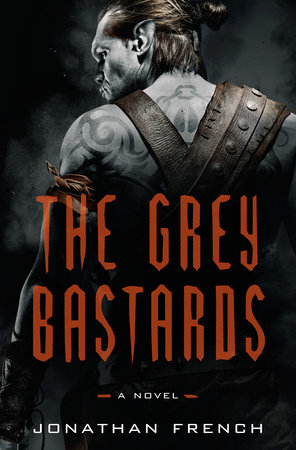 And the warhog-riding half-orc bikers of The Grey Bastards are the bad boys (and girl) of the orc world.
And the warhog-riding half-orc bikers of The Grey Bastards are the bad boys (and girl) of the orc world.
Mix Sons of Anarchy with Shadow of Mordor and you’ll get a world similar to the Lot Lands of Jonathan French’s The Grey Bastards, where gangs of orc-human hybrids ride monstrous swine called barbarians as they patrol their anarchic wasteland, keeping the humans of Hispartha safe on one side by fending off the raiding parties of full-blooded orcs that routinely probe their lands from the other.
Although, confession, I don’t know how accurate this analogy still is when it comes to quality, because I’ve never actually seen Sons of Anarchy or played Shadow of Mordor. I’ve heard pretty good things about both, though, which makes me think the comparison still holds up. Because I have read The Grey Bastards, and yeah, it’s good. It’s really, really good.
Read in the saddle, continue on the hog!
Tags: book, fantasy, indie author, Jonathan French, orcs, review, shelf life, story
Posted in Shelf Life: Book Reviews |
I love fantasy novels, but I have a hard time sticking with a series that has more than four books, especially if they follow a single main character. What can I say; I’m a trilogy kind of girl. However, Maria V. Snyder did an excellent job of keeping me hooked all the way through the end of her nine-book series, The Chronicles of Ixia (AKA Poison Study, AKA Soulfinder—publishers really need to learn to just find one series name and stick with it). It helps that the nine books are divided into three sub-trilogies.
The first trilogy, comprised of Poison Study, Fire Study, and Magic Study, follows Yelena Zaltana. The second series, also called the Glass series, follows her friend Opal Cowan in Storm Glass, Sea Glass, and Spy Glass. The final trilogy, Shadow Study, Night Study, and Dawn Study, is where things get a bit odd. Maria V. Snyder had thrown in a few short stories/novellas throughout from different characters’ points of view. Perhaps she got bored of just sticking to one POV, or maybe fans wanted more from the other characters, so the third trilogy is from Yelena’s POV in first person and the POV’s of multiple characters (mainly Valek, Leif, and Janco, with a few others popping in from time to time) in third person.
I’m not sure which editor thought it would be a good idea to have POV switch from first person to third person in the same novel, but—yikes—is it jarring. I don’t know if the editor thought readers would be too confused because the first two trilogies were first person, but I think the entire last trilogy should have been third person. Now, I will admit my bias here—I personally always prefer third person, and I especially love third-person limited that switches between multiple characters. I think the first two trilogies in the series would have been much stronger if they had been written as such.
But enough of my rant. Because even with the wonky POV stuff in the third trilogy, these books are amazing and absolutely worth your time to read. Snyder’s world-building is compelling, detailed, and original. The books take place mostly between two pre-industrial countries: Ixia and Sitia. Ixia is a post-revolution country ruled by Commander Ambrose. His personal body guard and assassin is Valek. In the first novel Yelena is in prison for murder and is offered the choice to be the Commander’s food taster in exchange for her life. She agrees, and throughout the first book she and Valek begin to fall in love.
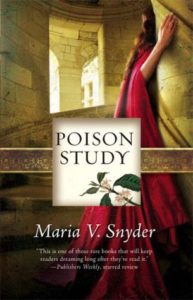

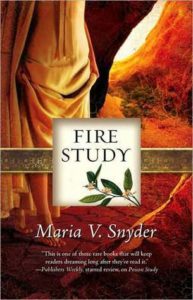
Keep studying
Tags: book review, Chronicles of Ixia, fantasy, Glass series, LGBTQ, magic, Maria V. Snyder, Poison Study, shelf life, Sitia, Soulfinder
Posted in Shelf Life: Book Reviews |
It’s been a while since my last review, in part because it’s been a while since the last time I read a book and came away with enough to say about it to warrant writing it up, but in bigger part because I’ve been working harder on a book of my own. My wife and I have recently finished writing our first full-length, publishable novel together and are now in the process of editing so we can start looking for an agent and a publisher. Between that and my new job, my blog’s fallen down the list of things toward which my literary efforts need to be put.
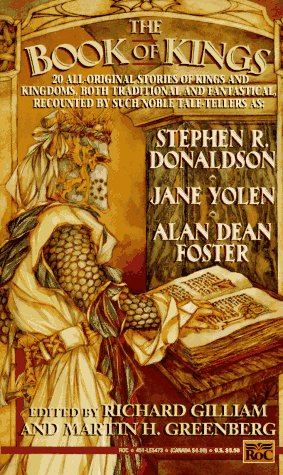 During the tail end of writing this novel, though, I pulled down The Book of Kings from our shelves, a collection of “20 all-original stories of kings and kingdoms, both traditional and fantastical, recounted by such noble tale-tellers as (a bunch of names that probably look at least somewhat familiar).” Our own story is largely centered around the activities of a royal family and the assassin who’s living in their midst, so I thought it would be a good source of inspiration and motivation while I already had kings and their doings on the brain.
During the tail end of writing this novel, though, I pulled down The Book of Kings from our shelves, a collection of “20 all-original stories of kings and kingdoms, both traditional and fantastical, recounted by such noble tale-tellers as (a bunch of names that probably look at least somewhat familiar).” Our own story is largely centered around the activities of a royal family and the assassin who’s living in their midst, so I thought it would be a good source of inspiration and motivation while I already had kings and their doings on the brain.
And as it turns out, I was right.
Read more; your king commands it
Tags: book, Martin H. Greenberg, paperback, review, Richard Gilliam, shelf life, short stories, story, The Book of Kings
Posted in Shelf Life: Book Reviews |
Starting a piece of writing can sometimes be one of the hardest parts of writing it, even for a book review, and especially for this one. I’ve been reading Jacqueline Carey’s adventures in Terre d’Ange for years now, starting with Kushiel’s Dart and just recently wrapping up Naamah’s Blessing. And I can honestly say that the nine books that comprise these three trilogies are among the best fantasy available today as well as nine of my all-time favorite books I’ve ever read. Ask me a question about some aspect of them and I can start rambling for an hour, but how do you pick a spot to begin at with this much to talk about?
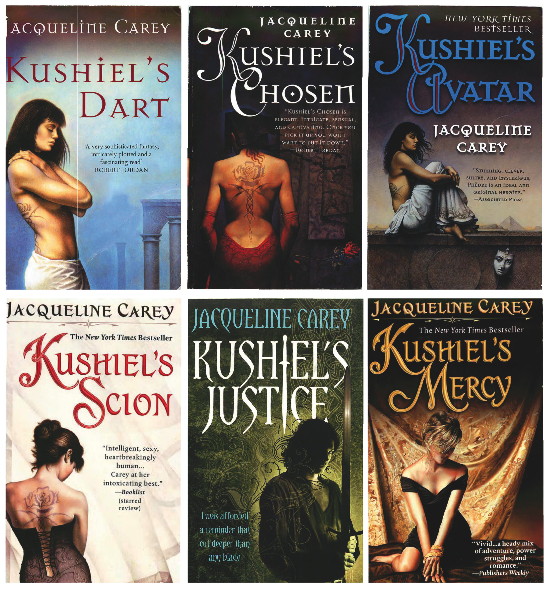
The first two-thirds of the awesome.
I’ve been meaning to review the Kushiel and Naamah books since I started this blog, but covering just one book on its own is no good – by now, they’ve all melted into one massive and epic storyline in my head spanning multiple generations of characters. Also, it’s been a while since I finished Kushiel’s Dart, and like most series, you have to start at the beginning to fully appreciate what comes afterward.
So instead of talking about a single book in the series or each one individually, I’ve decided instead to write one big ass review to cover my thoughts on the series as a whole. Call it a bittersweet celebration for my finally having finished the last book, a going away party as I finally leave Terre d’Ange behind. Also, seeing as how Ms. Carey herself recently sounded off on the feasibility of the whole shebang being adapted for screen, it’s almost timely.
Read as thou wilt
Tags: book, epic fantasy, fantasy, jacqueline carey, Kushiel's Dart, Kushiel's Legacy, Naamah trilogy, Naamah's Curse, review, shelf life, Terre d'Ange
Posted in Shelf Life: Book Reviews |
Very few fantasy fans can get away with admitting that they aren’t all that big into sweeping, high epic fantasy à la Lord of the Rings or the Pern stories or everything that Terry Brooks writes. Many non-fantasy fans, however, can point to these tales as examples of why they aren’t into fantasy. Like it or not, it’s hard not to see the latter group’s point, as a lot of high fantasy is riddled with confusing terminology, rehashed stories, and genre clichés. This is not to say that these stories are bad, per sé, just that they can easily turn off readers who aren’t in the right kind of crowd.
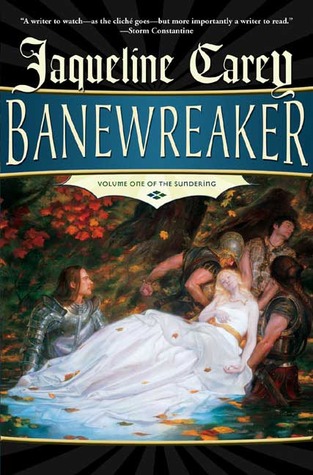 Banewreaker, the first book in Jacqueline Carey’s two-part volume The Sundering, will probably not change any opinions in this respect, then, as it’s sweeping high fantasy to the core. This, as it turns out, is both its greatest strength and its greatest weakness.
Banewreaker, the first book in Jacqueline Carey’s two-part volume The Sundering, will probably not change any opinions in this respect, then, as it’s sweeping high fantasy to the core. This, as it turns out, is both its greatest strength and its greatest weakness.
Read more about wreaked banes
Tags: banewreaker, book, epic fantasy, fantasy, jacqueline carey, paperback, review, shelf life, story, tragedy
Posted in Shelf Life: Book Reviews |
Fantasy and satire are two of my favorite genres in any medium, but especially so in books. Satirical fantasy, then, holds a special place on my shelves. I grew up on Sir Terry Pratchett’s Discworld series, and desire to imitate him and his style is what led me in middle school to begin writing in earnest, for fun, and for myself rather than just for my teachers and their assignments.
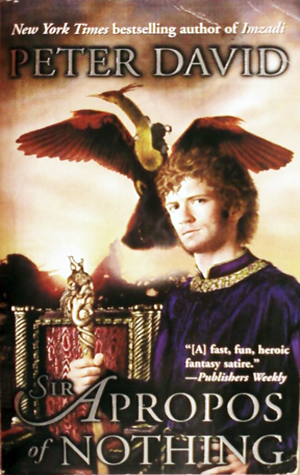 So when I picked up Sir Apropos of Nothing, I did so based on the title pun and the back-of-the-book synopsis that promised “a berserk phoenix, murderous unicorns, mutated harpies, homicidal warrior kings, and – most problematic of all – a princess who may or may not be a psychotic arsonist.” I expected another lighthearted riff on the familiar archetypes. Murderous unicorns? Unicorns are not typically described as such! Oh teehee, how unexpectedly humorous!
So when I picked up Sir Apropos of Nothing, I did so based on the title pun and the back-of-the-book synopsis that promised “a berserk phoenix, murderous unicorns, mutated harpies, homicidal warrior kings, and – most problematic of all – a princess who may or may not be a psychotic arsonist.” I expected another lighthearted riff on the familiar archetypes. Murderous unicorns? Unicorns are not typically described as such! Oh teehee, how unexpectedly humorous!
Read more about nothing
Tags: book, fantasy, paperback, peter david, review, satire, shelf life, sir apropos of nothing, story
Posted in Shelf Life: Book Reviews |
(I’m gonna go ahead and throw a disclaimer on up here: You are about to read something that deals with purportedly “erotic” subject matter. If you don’t like the sound of that word, you might wanna go elsewhere. If it’s actually-erotic things that offend you, though, you’ll be fine.)
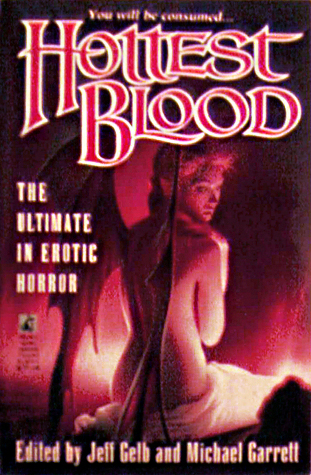 I like short story compilations because you get a variety of content that’s just as easy to breeze through if you have the time as it is to get to a stopping point and put down if you don’t. I like horror fiction because it usually involves the super-natural, which interests me, and intense emotional responses, which are almost always a good thing in writing. And I like eroticism because I am a warm-blooded human being with a pulse. However, on the whole, I do not like Hottest Blood.
I like short story compilations because you get a variety of content that’s just as easy to breeze through if you have the time as it is to get to a stopping point and put down if you don’t. I like horror fiction because it usually involves the super-natural, which interests me, and intense emotional responses, which are almost always a good thing in writing. And I like eroticism because I am a warm-blooded human being with a pulse. However, on the whole, I do not like Hottest Blood.
I wanted to, I did. Look at that cover. It’s equal amounts scary and sexy, both in completely safe, PG-13-at-most kind of ways. Unfortunately, Softcore Succubus here is both the scariest and the sexiest thing about this book
Bluntly analogized, you know that feeling you get when you come across something on the internet that disturbs and/or disgusts you, and then you learn that there’s a dedicated group of people that gets off on it? Most of the stories in this book are that feeling captured in words.
Case in point, the story “Damaged Goods” by Elizabeth Massie, which as far as I can tell is about a couple of physically abused, emotionally damaged, developmentally stunted kids somewhere around their early teens who live with a religious fringe cult being led out to a field to have sex with each other while a nameless U.S. President watches and masturbates before both kids are drowned in a river by their preacher/pimp caretaker.
Or there’s “Mr. Right” by Chris Lacher, which tells the story of a college student named Russ who has a secret fetish for the deformed women in the freak show at a nearby carnival – a fascination which leads to him getting held down and forcibly raped by a group of unwashed subhuman mutants, which the detailed descriptions make sure you understand are completely revolting to all five senses. The story ends with him being dumped out behind the fairgrounds while a small, legless girl happily informs him that this is how all carnival workers reproduce, and he can look forward to seeing his own mutant rape-spawn in the show next year.
Or there’s “Abuse” by Matthew Costello, which simply shows us how the arrest of a Peewee Herman surrogate goes down in an adult movie theater before ending with another man jerking off with the cold, dry, severed hand in his pocket as he contemplates getting a new one to replace it.
The tone of these three are pretty much par for the course for the rest of the book: thoroughly disturbing, and sex is involved, but the disturbing feeling stems from revulsion rather than fear, and the sex bits are so far on the other end of the spectrum from erotic that it feels like the authors are trying to punish their readers for even expecting to be aroused in any way.
Of course, I said myself earlier that intense emotional responses are “almost always a good thing in writing.” By that merit alone, this book technically succeeds; in fact, if it had billed itself as shock fiction instead of erotic horror, I’d begrudgingly give it a medal in its class. The “aw, what the hell?!” moments are not as artistically executed as, say, a Chuck Palahniuk read, and they tend not to have as much depth to them, but strictly in terms of making you wish that you could unread words, they get the job done.
But that isn’t the job that Hottest Blood was hired to do, and that’s not what it put on its resume. It said it was going to “heat the blood and chill the mind,” and promised that “terror never felt this sexy!” It would have been more appropriate to say that “sex never felt this terrible.”
All of that said, if you abandon any hope of seeing anything resembling erotica or horror (scary horror, anyway), there are a few stories in here that are decent reads – mostly because they try to say something with their subject matter rather than use it to see how thoroughly they can ruin the idea of sex for the reader. To give a few quick nods of approval:
- Nancy Holder’s “I Hear the Mermaids Singing,” which opens the anthology, is a dark and modern re-imagining of “The Little Mermaid” that brutally points up the drawbacks to throwing away your whole life and family in order to pursue someone that you know nothing about outside of a few fleeting glimpses and lustful inner fantasies.
- J.L. Comeau’s “Black Cars” is the narrative of a high-class chauffeur as he tells his passenger an increasingly mysterious story about a couple of his regular customers, culminating in a creepy twist payoff that, in retrospect, actually makes it count as a legitimate horror story, and a decently gripping one at that.
- And “Safe at Home” by Steve and Melanie Tem, while decidedly and disturbingly unsexy, at least has good reason to be; it’s a short character study of a young woman who’d been molested as a child, and the lasting and complex psychological damage resulting thereof that prevents her from having any normal social life or relationships, even with someone whom she legitimately likes, someone who knows what’s happened and sincerely cares for her.
So for the handful of intriguing stories that don’t make you quit (or wish you had) mid-read out of revolted disappointment, I can’t completely condemn Hottest Blood. If you want to test your own threshold for repulsion but are understandably hesitant to use online image searches to this end, I heartily recommend it.
If you are legitimately turned on by the idea of a man eating a woman alive and then gestating her alien spawn inside his own bloated body until his head detaches and crawls away (“How Deep the Taste of Love,” John Shirley), I suppose I still heartily recommend it, though I do so from a safe distance.
If you want to read one of the few stories involved that aren’t horrible, I heartily recommend trying to find them on their own somewhere else first.
But if you want “the ultimate in erotic horror,” stay the hell away. Softcore Succubus is a trap.
Tags: book, erotic, horror, hottest blood, jeff gelb, michael garrett, paperback, review, shelf life, short stories
Posted in Shelf Life: Book Reviews |
(Since I want to keep this blog with some sort of momentum but have been lacking the time to do anything about it for the past few weeks, enjoy this book review from an earlier, temporary blog that I had going for a class, in which I pretended I was a dragon with a computer, edited to remove any reference to me being a dragon with a computer, as I am in actuality not one of those.)
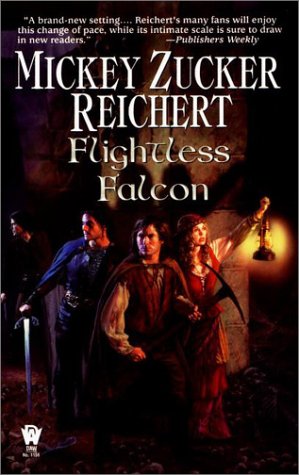 Flightless Falcon is a light DAW fantasy by Mickey Zucker Reichert that first came out in paperback in July of 2001. Set in your typical fantasy land – lightly coated in magic but sans any fantastical creatures such as dragons, elves, dwarves, and the like – it follows the sad, luckless exploits of an ex-miner named Tamison made useless after a cave in kills his father and brother and leaves him trapped deep in the mine for a few days.
Flightless Falcon is a light DAW fantasy by Mickey Zucker Reichert that first came out in paperback in July of 2001. Set in your typical fantasy land – lightly coated in magic but sans any fantastical creatures such as dragons, elves, dwarves, and the like – it follows the sad, luckless exploits of an ex-miner named Tamison made useless after a cave in kills his father and brother and leaves him trapped deep in the mine for a few days.
Read more about falcons and their flightlessness
Tags: book, fantasy, flightless falcon, mickey zucker reichert, paperback, review, shelf life
Posted in Shelf Life: Book Reviews |
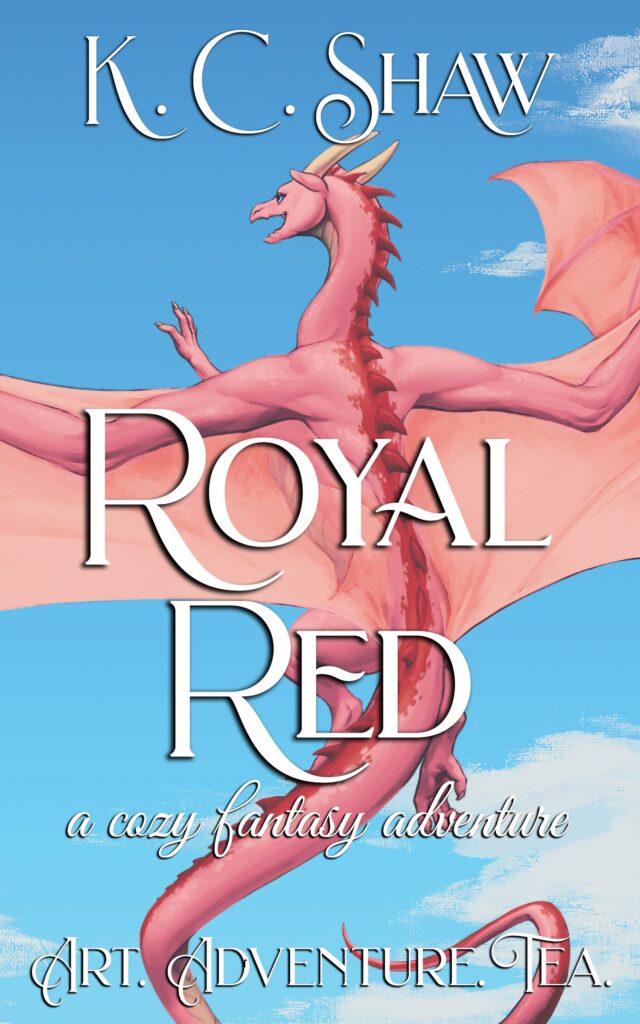
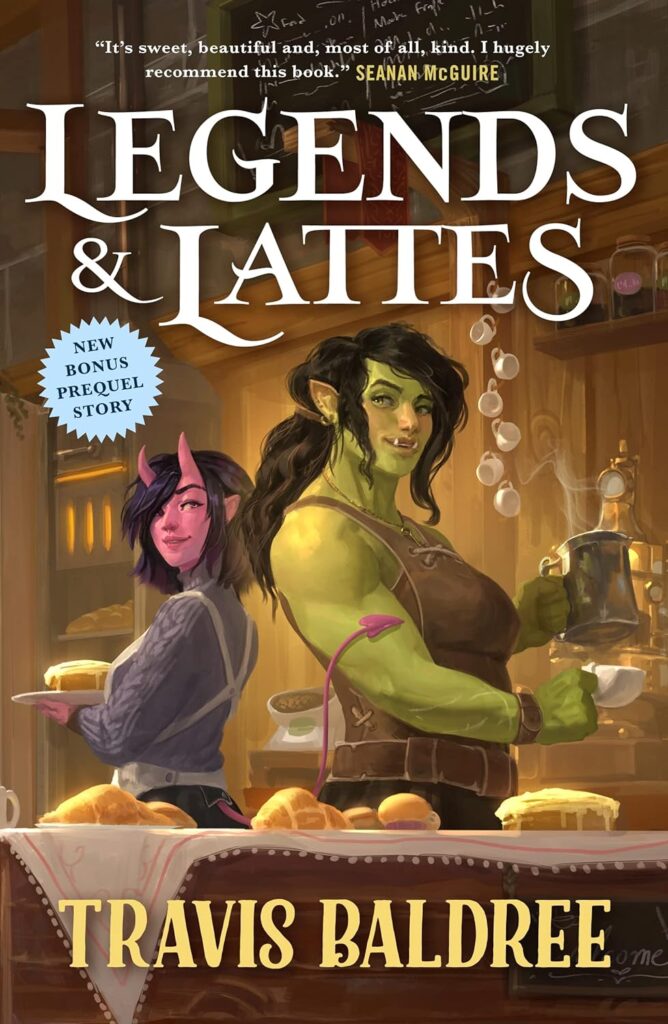
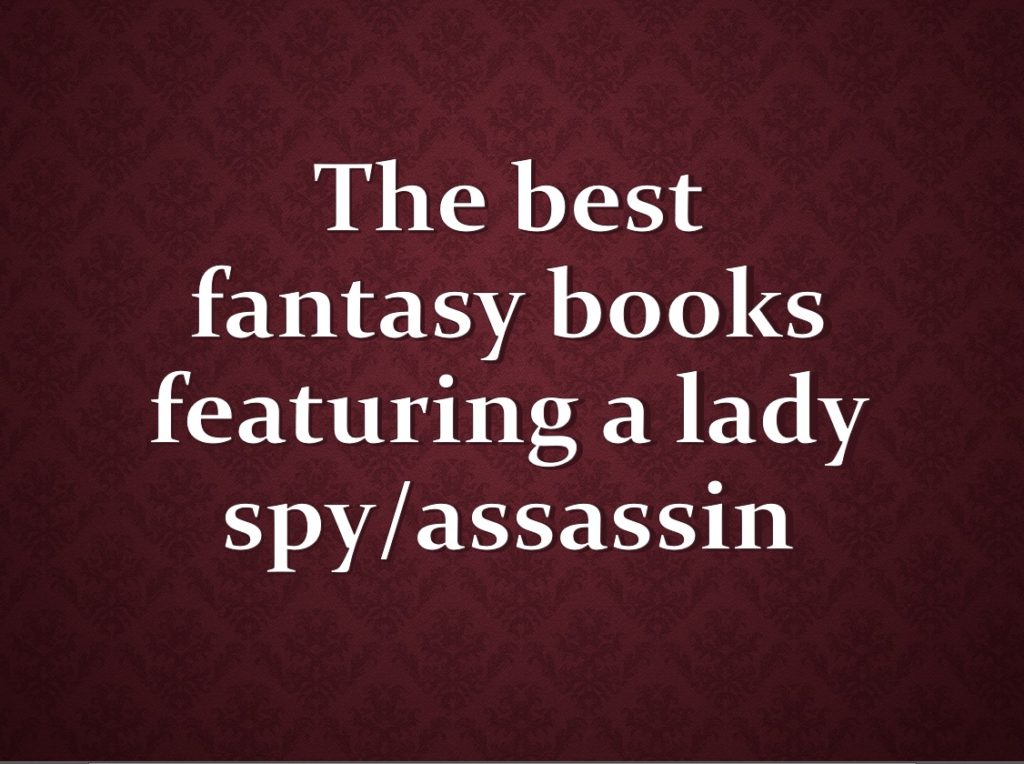
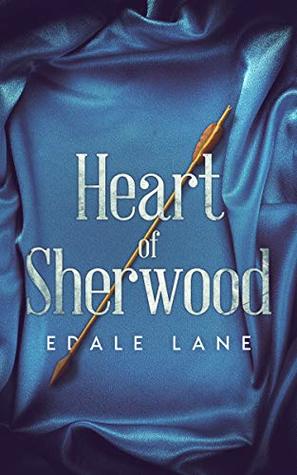
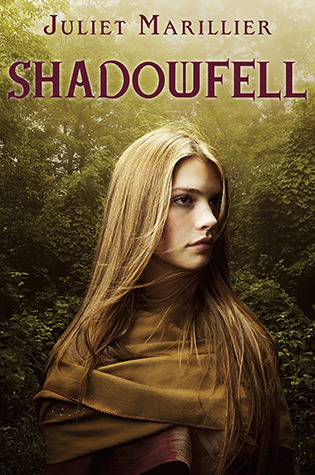
 Seafire is a swashbuckling dystopia following Caledonia Styx, a young woman on the run from a powerful warlord Aric Athair. After her family is ambushed and murdered by a crew of the warlord’s Bullets — loyal soldiers groomed from childhood for violence and controlled by mandatory drug addiction — Caledonia is forced to turn from refugee to pirate captain, sailing the high seas with her all-female crew of rebels and renegades aboard the Mors Navis, taking the fight to Aric’s forces by targeting his fleet of floating garden barges where the flowers that fuel his drug production are grown.
Seafire is a swashbuckling dystopia following Caledonia Styx, a young woman on the run from a powerful warlord Aric Athair. After her family is ambushed and murdered by a crew of the warlord’s Bullets — loyal soldiers groomed from childhood for violence and controlled by mandatory drug addiction — Caledonia is forced to turn from refugee to pirate captain, sailing the high seas with her all-female crew of rebels and renegades aboard the Mors Navis, taking the fight to Aric’s forces by targeting his fleet of floating garden barges where the flowers that fuel his drug production are grown.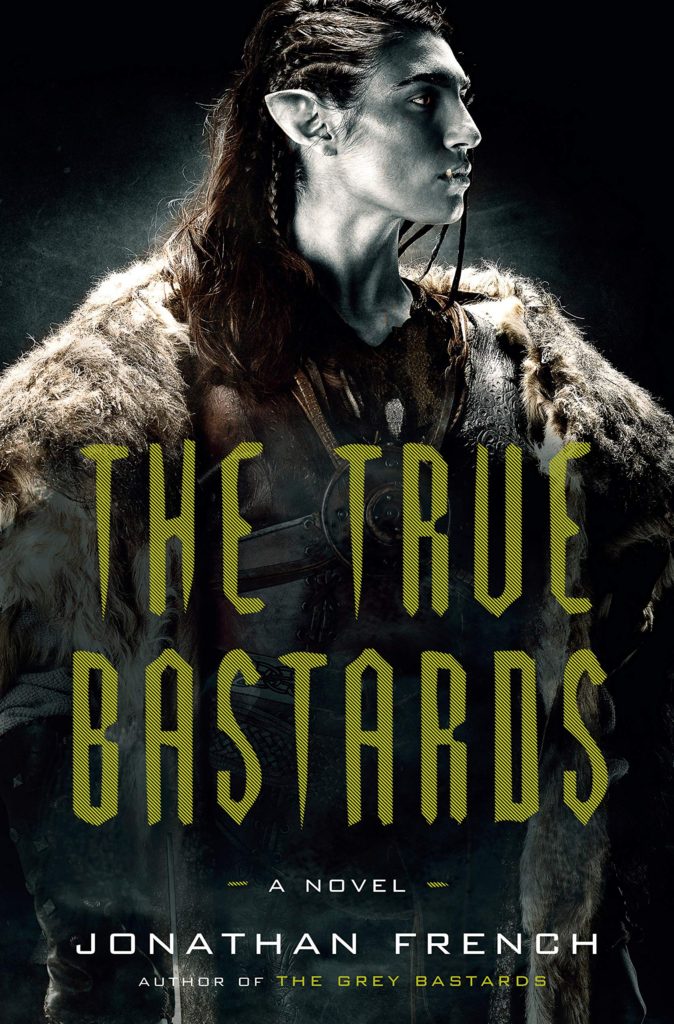
 Dragon Apocalypse: The Complete Collection by James Maxey is a thick-as-a-brick compilation of four hack-n-slash action fantasy novels (plus the original short story that inspired them): Greatshadow, Hush, Witchbreaker, and Cinder (plus “Greatshadow: Origins”).
Dragon Apocalypse: The Complete Collection by James Maxey is a thick-as-a-brick compilation of four hack-n-slash action fantasy novels (plus the original short story that inspired them): Greatshadow, Hush, Witchbreaker, and Cinder (plus “Greatshadow: Origins”).
 But beyond the technicalities of publishing, pulp fiction also developed a sort of overarching genre definition based on some recurring themes that tended to crop up in the stories again and again, regardless of categories like fantasy, noir, horror, etc. — namely, big, bombastic heroes squaring off against sinister, mysterious villains in dangerous, exotic locales, featuring beautiful women of both the damsel and the deadly variety.
But beyond the technicalities of publishing, pulp fiction also developed a sort of overarching genre definition based on some recurring themes that tended to crop up in the stories again and again, regardless of categories like fantasy, noir, horror, etc. — namely, big, bombastic heroes squaring off against sinister, mysterious villains in dangerous, exotic locales, featuring beautiful women of both the damsel and the deadly variety.

 And the warhog-riding half-orc bikers of The Grey Bastards are the bad boys (and girl) of the orc world.
And the warhog-riding half-orc bikers of The Grey Bastards are the bad boys (and girl) of the orc world.


 During the tail end of writing this novel, though, I pulled down The Book of Kings from our shelves, a collection of “20 all-original stories of kings and kingdoms, both traditional and fantastical, recounted by such noble tale-tellers as (a bunch of names that probably look at least somewhat familiar).” Our own story is largely centered around the activities of a royal family and the assassin who’s living in their midst, so I thought it would be a good source of inspiration and motivation while I already had kings and their doings on the brain.
During the tail end of writing this novel, though, I pulled down The Book of Kings from our shelves, a collection of “20 all-original stories of kings and kingdoms, both traditional and fantastical, recounted by such noble tale-tellers as (a bunch of names that probably look at least somewhat familiar).” Our own story is largely centered around the activities of a royal family and the assassin who’s living in their midst, so I thought it would be a good source of inspiration and motivation while I already had kings and their doings on the brain.

 So when I picked up Sir Apropos of Nothing, I did so based on the title pun and the back-of-the-book synopsis that promised “a berserk phoenix, murderous unicorns, mutated harpies, homicidal warrior kings, and – most problematic of all – a princess who may or may not be a psychotic arsonist.” I expected another lighthearted riff on the familiar archetypes. Murderous unicorns? Unicorns are not typically described as such! Oh teehee, how unexpectedly humorous!
So when I picked up Sir Apropos of Nothing, I did so based on the title pun and the back-of-the-book synopsis that promised “a berserk phoenix, murderous unicorns, mutated harpies, homicidal warrior kings, and – most problematic of all – a princess who may or may not be a psychotic arsonist.” I expected another lighthearted riff on the familiar archetypes. Murderous unicorns? Unicorns are not typically described as such! Oh teehee, how unexpectedly humorous! I like short story compilations because you get a variety of content that’s just as easy to breeze through if you have the time as it is to get to a stopping point and put down if you don’t. I like horror fiction because it usually involves the super-natural, which interests me, and intense emotional responses, which are almost always a good thing in writing. And I like eroticism because I am a warm-blooded human being with a pulse. However, on the whole, I do not like Hottest Blood.
I like short story compilations because you get a variety of content that’s just as easy to breeze through if you have the time as it is to get to a stopping point and put down if you don’t. I like horror fiction because it usually involves the super-natural, which interests me, and intense emotional responses, which are almost always a good thing in writing. And I like eroticism because I am a warm-blooded human being with a pulse. However, on the whole, I do not like Hottest Blood. Flightless Falcon is a light
Flightless Falcon is a light 
